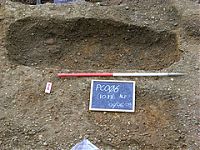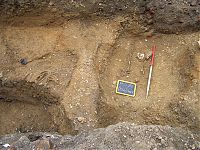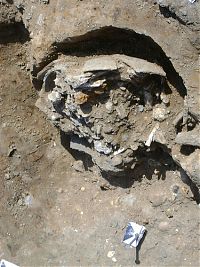Burial Practices in the East London Roman Cemetery
The Law
According to the Roman Lex Duodecim Tabularum, the Law of the Twelve Tables, burials could not have taken place within the boundary of any settlement anywhere in the Roman Empire.
A town of multiple beliefs
The Roman Empire was multicultural to say the least, and a diverse number of religious beliefs were practised and tolerated. Many religious beliefs were capable of assimilating ideas from other practices. The people inhabiting Roman Londinium had a multitude of funerary practices that reflected the diversity of religious beliefs; burial customs were adopted, adapted and abandoned over time from all parts of the empire, and fashions were followed, just as fashions changed in other areas of day-to-day life. London would have been the first area to adopt new burial customs as people from almost every area of the Roman Empire and beyond may have lived in or visited Londinium, and their Oriental and Roman religious beliefs would have stood alongside indigenous faiths as well as hybridizations. Sources for indigenous religious beliefs are either Classical authors or sources first committed to paper in the Medieval period, so can be considered tenuous at best.
The differences found in grave goods and burial types in the East London Roman Cemetery and beyond may suggest that the inhabitants were demonstrating their cultural identities and traditions, following religious beliefs, or perhaps simply being pragmatic, and performing whatever style of funeral they could afford. Burial practices of eastern origin were found as far west as Britain. Most burials took place with the care and respect to the deceased that we would expect today. Without scientific methods of analysis, such as DNA or isotope studies, it is almost impossible to suggest where the dead came from in life – were they native to Britain, or from the far-flung reaches of the Empire? In 1999, archaeologists from the Museum of London discovered a Roman burial in a lead coffin, inside a sarcophagus. This female was buried sometime in the 4th century AD, and isotope and DNA analysis of her teeth indicated that she had spent her early years in a warm country and possessed similar DNA to the inhabitants of modern Spain.
Burial Types and Rites
The East London Roman Cemetery has examples of many different types of burials and burial rites, a really rich diversity of activity that indicates the extent to which Roman culture permitted a wide range of beliefs and ritual practice. The most common rites are cremations buried in urns and supine inhumations. There is good evidence for the use of wooden coffins from many of the burials. The burials generally follow the cemetery alignment being either roughly East – West or North – South on the alignment. There is a rich diversity of grave goods deposited within and alongside the burials and cremations. These range from small personal possessions such as jewellery and dress fittings to statues and larger vessels.
Inhumation burials
The Barber and Bowsher study of the East London Roman Cemetery recorded 550 burials, including infants. The male to female ratio was 1.7:1, which seems to compare to other urban settlements in Britain as the average urban sex ratio. The burial styles from the East London Roman Cemetery were a mixture of native and continental styles, and are very similar in form and content to other Romano-British urban cemeteries. A few of the East London Cemetery burials were unusual. What may be native “British” religious practises have been identified in some of the burials in the East London Roman cemetery through the apparently unusual treatment of the human head in 7 burials. The skulls belonging to these 7 burials had been moved; some to between the legs, some onto the pelvis. There is no evidence that the heads were removed by cutting – and may have been removed after the flesh had decomposed. Conversely, these may have also been disturbed at a later date by other activity in the East London Cemetery area – since the area is known to have been quarried for building materials in both the Roman and post-Medieval periods.
Child burials
There is a low recovery of the remains of infants from Romano-British cemeteries across Britain. It is especially noticeable in the Eastern Roman Cemetery, although it may be possible that there was a tradition of burying infants and young children separately from adults, or even within settlements instead of outside them. Young children were not seen by the Romans as fully fledged human beings and this did not begin to change until the 3rd and 4th centuries. As a result, infants were not accorded similar funeral rites as adults. Infanticide is an aspect of Roman practise that is well documented in written records, and it has been suggested by some archaeologists that this can be seen in the archaeological evidence as well. Simon Mays, a human bones specialist at English Heritage, has carried out research into infanticide (British Archaeology, March 1995). He examined the skeletons of 164 children of late Roman date who died at or around birth, and by measuring their long bones, he established that a significant proportion died at around full term – the pattern expected for infanticide. In modern societies, by contrast, perinatal deaths (such as stillbirths and natural deaths in the immediate post-natal period) have a fairly flat age distribution, with no marked peak at full term. However, it is also possible that most infants were not born and raised in Londinium, or that any child mortalities were dealt with through methods that do not leave a trace in the archaeological record – perhaps disposal in the Thames and her tributaries was common.
Female burials
Another feature noted in the excavations of the East London Roman Cemetery is the relatively low number of female graves found. In Britain, there are many cemeteries where this phenomena is well known. Excavations at the South London Roman Cemetery in Southwark found twice the number of males graves as female. This may simply reflect some social and cultural groups who practiced the separation of sexes in death, and had specific areas of burial for women that have not yet been discovered. Given the number of cemeteries known throughout London, this is unlikely. Perhaps there was a higher ratio of men to women in Londinium, with a large number of unmarried soldiers and civil servants in the town, or that women were buried in more rural areas rather than just outside the town – or even that it was more common for women to be cremated than men. At the Prescot Street excavation, we have found two shale or jet ‘bangle’ type bracelets and four jet or shale transversely perforated pyramidal beads. The majority of shale or jet jewellery from Roman Britain is found in female graves or interpreted for female use, so, although these objects were not found in a secure burial context, it does suggest that female burials were taking place on site.
Cremation burials
In the East London Roman Cemetery, about 112 – 134 cremation burials were identified during the excavations in the 1980’s and 1990’s, although many cremations had been moved and were not in containers such as urns. The sex ratio seemed to differ slightly to inhumation burials – roughly 1:2.1 males to females, suggesting it was more common for more women than men to be cremated. Some of the cremation burials appeared to be bustum type cremations, where the cremations were buried in situ – in other words, the bodies were burnt and then buried in the same spot, rather than being burnt in one area and moved to be placed in the cemetery.
The cremation burials in the East London Roman Cemetery took place amongst much drinking and libation. A significant number of vessels that accompany the burials were drinking vessels. This appears to confirm that it was more important to drink than eat around the graves, although charred plant remains were recovered in some burials which are common on Continental sites but almost unique in England. Widespread survival of charred lentil, pea and Celtic bean seeds in cremation burials from the East London Cemetery seem to have been deposited when the pulses were still raw, not dried as is common in modern cooking. There is evidence that these types of foods were in use in pre-urban Rome as well as in France and Germany, and suggest that the deposition of these plants is a longstanding Roman burial custom.
- Author: Lorna Richardson |
- Jul 22, 2008
- Share



